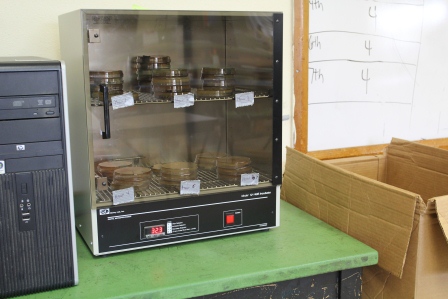What’s living among us?
April 22, 2015
They are everywhere. They are the invisible invaders. They are bacteria.
On March 25 , the juniors of AP Biology conducted an experiment testing different surfaces around the school for bacteria. Biology teacher Adam Stroud began the class by passing around a petri plate and allowing students to touch a petri dish with their fingers before they began their swabbing. Stroud said the petri dish contains a hard jelly called agar, which has nutrients for the bacteria to grow and develop, and this allows you to see the bacteria.
The results were both astonishing and disgusting. After just two days, the petri dish that the students had touched had produced 12 types of bacteria, including streptococcus which is the cause of strep, staphylococcus, which causes staph infections, escherichia coli and three types of unidentified fungus.
Stroud’s aim was to help the students learn that bacteria are everywhere and not necessarily bad things, but in fact that some bacteria are actually good and are helping our bodies stay healthy. For instance, Lactobacillus, a bacteria commonly found in yogurt, helps your gut digest your food. According to Stroud, whenever someone “toots,” they release methane which is produced by bacteria that lives inside their digestive tract because the bacteria is trying to break down your food.
Although there are bacteria everywhere, you only get sick if the right type of bacteria enters your system. When you breathe in what someone might have sprayed into the air, or touch a surface someone had just sneezed on and rub your eyes or nose bacteria can enter your system. A bacteria’s life span also varies depending on what type it is. They could live minutes or even up to a year.
Stroud said, “Thank goodness your have an immune system.” Our immune systems help defend our bodies against harmful viruses, bacteria and fungi.
Juniors Julissa Soto, Natalia Arras, Jordan Fieris and Damaris Lopez had varying results for the experiment.
Soto swabbed the cafeteria lunch table. Bacteria had grown on her petri dish but fungus also grew. Stroud said that because the fungus releases spores into the atmosphere, that it would be safer if those petri dishes remained closed. Soto was surprised that fungus grew on the tables where she eats. She found it interesting that her class had the chance to compare the method of growing bacteria to how doctors would.
Arras swabbed the change slot on the vending machine and it also grew a fungus. Lopez swabbed the girl’s toilet handle, and she explained that only “a little speck” of bacteria grew but it possibly because she swabbed it early in the morning.
After the experiment and learning about bacteria, Lopez felt a bit germaphobic. Fieris swabbed the girls toilet seat. She identified a form of strep.
“The toilet seat had alone eight different types of bacteria and just in one spot so you never know what’s growing around the rest of the toilet, so I learned that it can be more than one bacteria in one area,” Fieris said.
Fieris liked the interactive project. She thought the experiment was beneficial and fun.









